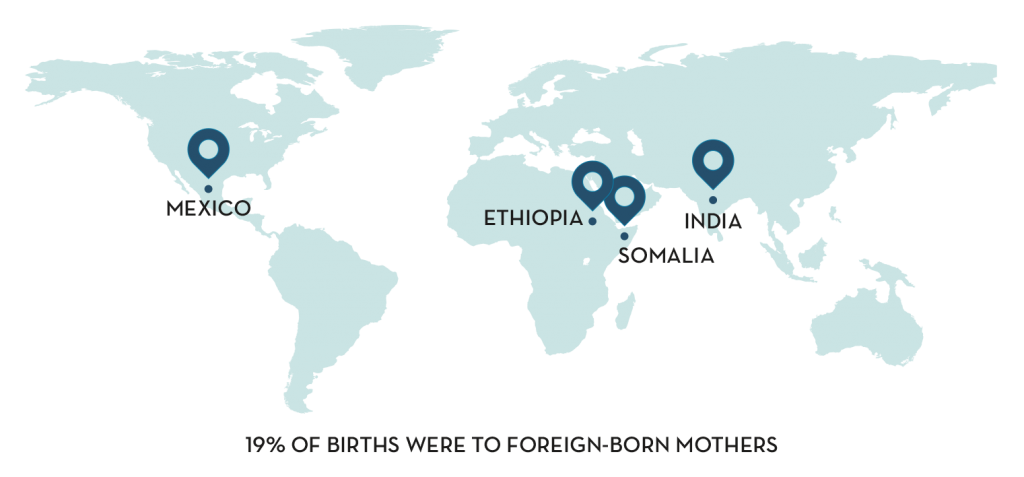(Sources: Much of the data in this section are retrieved from 2017 Minnesota health statistics annual summary available here).
Top Four Countries of Origin
for Women Giving Birth in MN (source)

In 2017, there were a total of 78,227 pregnancies in MN. The pregnancy rate was 73.3 per 1,000 women ages 15-44. The state counted a total of 68,603 live births (all singleton and multigestation included), of which 8.9% were premature (less than 37 weeks of gestation) and 6.8% were low birth weight (less than 2,500 grams/5 pounds, 8 ounces) (source, sheet 2).
In 2016, among singleton births, there were 3,328 (4.9%) low birth weight, 4,652 (6.9%) premature birth weight and 2.8% small for gestational age (source, sheet 2).
- Healthy People 2020 targets (source)
- Low birthweight target: 7.8%
- Very low birthweight: 1.4%
- Total preterm birth: 9.4%
In 2015, 6.4% of MN births were to mothers who had gestational diabetes; this does not include women who had type 1 or type 2 diabetes before pregnancy.
In general, the rate of chlamydia in MN reached an all time high at 444 per 100,000 people. This is an increase of 4% from 2016. The rate of gonorrhea in MN increased 28% to 123 per 100,000 compared to 96 per 100,000 in 2016. The rate of primary and secondary syphilis is at 5.5 per 100,000. This is a decrease of 5% from 2016 (source).
The lowest case of early syphilis among women occurred in 2007, with two reported cases. This number has been steadily increasing since then and reached 91 cases in 2017. The following share the largest proportions of the number of women infected:
1. American Indian: 35%
2. White non-Hispanic: 29%
3. Black non-Hispanic: 23%
Females age 20-24 have the highest rate of chlamydia in the state (~3,400 cases per 100,000 person). In the 20-24 age group, males have a slightly higher rate of gonorrhea cases per 100,000 people compared to female cases of gonorrhea, with 500 and 478 cases per 100,000 people respectively.
- Tested for HIV HIV/AIDS
- Health Status for postpartum care
- Private insurance: 55.2%
- Medicaid: 29.1%
- No insurance: 14.9 %
The numbers reported here come from MDH, and were also retrieved from the 2017 Minnesota health statistics annual summary and the CDC BRFSS). They include the sexually transmitted infections (STIs) reported in different services throughout the state. It should be noted that the All Payers Claim Database would be a better resource to capture the number of individuals tested.
In 2016, among singleton births, there were 3,328 (5%) with low birth weight, 4,652 (7%) premature births, and 3% of births were small for gestational age. There was a decrease of 2% in the birth rate between 2016 and 2017. In 2016, 19.2% of births were to foreign-born mothers.
Details/Sources
- Fertility rate: 64.3 births per 1,000 (women ages 15-44 years) (source)
- Crude birth rate: 12.3 per 1,000 total population (source: 2017 Minnesota health statistics annual summary, p. 6)
- Birth rates: 12.3 per 1,000 total population (source)
- 77% of pregnant mothers received prenatal care in the first trimester
- Live births by race and ethnicity of mother (source)
- 5.2% of young women of reproductive age adopt continuous-use long-acting reversible contraceptives (LARCs) in MN health care programs (Medicaid) (source)
- Postpartum depression
- 10.5% of mothers were told by a provider they had depression before pregnancy
- 12.8% of mothers self-reported postpartum depression symptoms
- 24.1% women were obese pre-pregnancy in 2015 (source: PRAMS 2012-2015).
See “About the Data Sources” for more details on how data were collected.